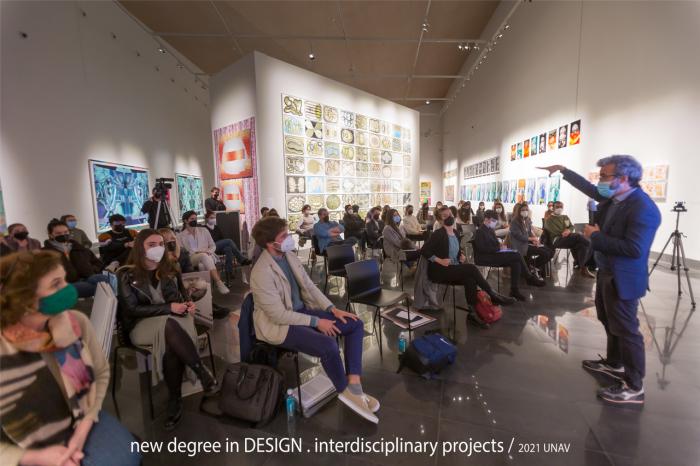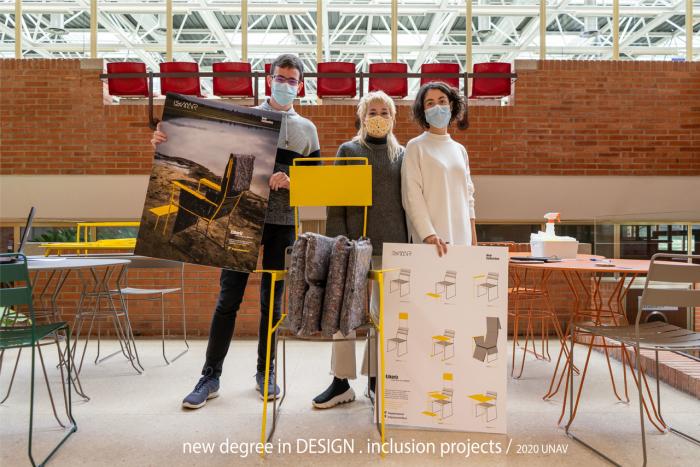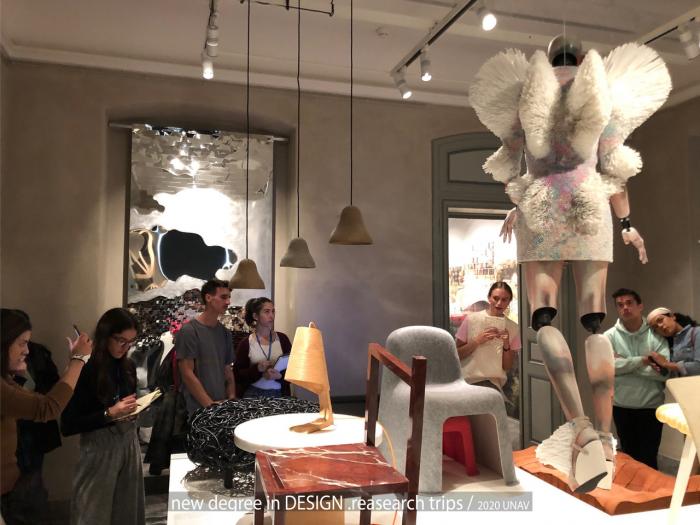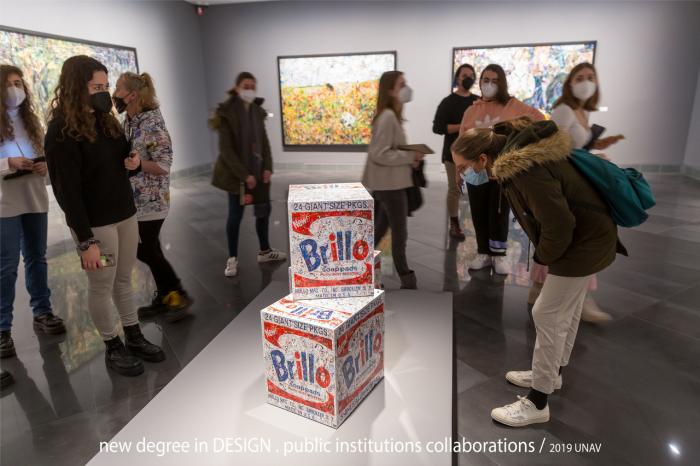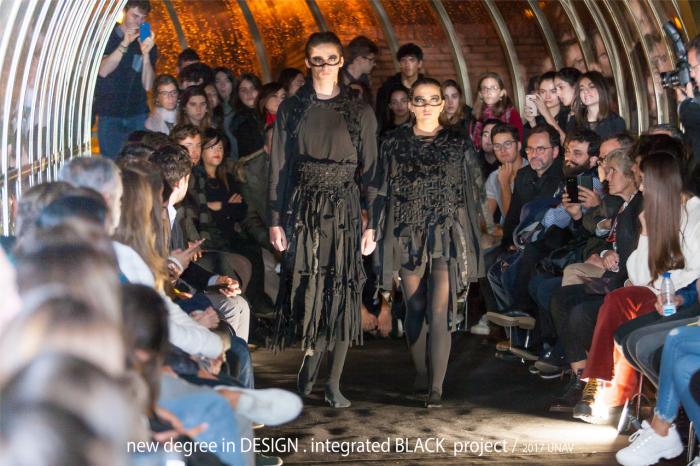I. SUMMARY INFORMATION
Project
268466
Status
Submitted
Award category
Interdisciplinary education models
You want to submit
NEW EUROPEAN BAUHAUS AWARDS : existing completed examples
Project title
Degree in Design. Universidad de Navarra
Full project title
New Degree in Design. Universidad de Navarra: Interdisciplinary integrated project-based learning
Description
The new "Degree in Design. Universidad de Navarra" is an experience that fits perfectly within the framework pursued by the "New European Bauhaus wave", it is a teaching methodology that integrates the theoretical, practical, technical, and creative contents, which acquire their whole meaning applied to a project. The students, through the practical and creative exercise of the project, can connect and understand the whole constellation of subjects, ideas and teachings offered to them.
Where was your project implemented in the EU?
Spain
Navarra
Campus Universitario
42°-48'-4" N
1°-39'-38" W
Pamplona
31009
When was your project implemented?
Has your project benefited from EU programmes or funds?
No
Which programme(s) or fund(s)? Provide the name of the programme(s)/fund(s), the strand/action line as relevant and the year.
II. DESCRIPTION OF THE PROJECT
Please provide a summary of your project
We submit the project "Degree in Design. Universidad de Navarra" to the "Interdisciplinary Education Models" category. It is an experience that fits perfectly within the framework pursued by the "New European Bauhaus wave".
The new Degree in Design was launched in September 2016 under the leadership of Dean Miguel Alonso del Val and professors Carlos Naya and Carlos Chocarro, and has recently completed the cycle of its first-generation of students. The shaping process of this degree was intended to be flexible to forge the profile of a versatile and creative designer, a process that would lead to a new and innovative configuration of teaching methodologies based on the integration of contents and competences through projects.
It is only fair to mention some educational systems that were part of the initial research that led to the structure of the degree: mainly Bauhaus and later HFG-Ulm and Black Mountain College. These approaches to design education are still at the core of current discussions in the pedagogy of design and the creative realm. All these experiences, in fact, shared a common concern in tackling design education from a holistic, interdisciplinary, practical, and project-centered point of view.
This teaching methodology integrates the theoretical, practical, technical, and creative contents, which acquire their whole meaning when they are perceived simultaneously and always applied pragmatically to a project. Thus, the students, through the practical and creative exercise of the project, can connect and understand the whole constellation of subjects, ideas and teachings offered to them. That is why the word “integration” is particularly appropriate in this case. In fact, the ideal name for this system would probably then be “integrated project-based learning.”
If the contributions of the different courses are correctly coordinated, the student can incorporate the different approaches with significant depth and perspective.
Please give information about the key objectives of your project in terms of sustainability and how these have been met
For us, what is sustainable has to do with a new way of understanding the profession, where knowledge is integrated, and the discipline is thought in a sustainable way across its entire spectrum. Of course, it is about recycling and upcycling our past errors and successes, but even more important it is about circular design and zero waste generation in our present and future projects. In our degree, the first two years are common for all students and the final two years are split in three different areas of interest—fashion, product, and service design. The intention is also to combine in a transversal manner both the humanistic and technical fields. The fact of having “common” first and second years materializes that desire to train designers “with broad foundation”. The intention in those two years is to open the spectrum and confront them with interdisciplinary challenges through integrated projects. For example:
We are fed up with dead objects. Recycle has a clean sheet point where you take objects and transform them back into raw material to do other things. The “Upcycling project” in the 1st year aims to give a second life and greater durability to objects with small design transformations. Especially those that have just one use: e.g. the cork of a wine bottle. With a set of corks this year some students made a stool. The ingenuity you need to be able to give that second life is through system unions. It might be harder to design a system than an object. True. However, if you manage to create a smart one, the possibilities will be endless. Forever.
The “My-tool project” (2nd year) is proposed to deconstruct an everyday object starting from the general, to reach each of its components, in a process -reverse engineering- that aims to "interrogate" each and all the elements that are found inside. Finally, the object must be transformed, opening new functional, material and / or formal possibilities under a purposeful, free and open experimentation.
Please give information about the key objectives of your project in terms of aesthetics and quality of experience beyond functionality and how these have been met
To train these new designers, we have focused the teaching in this discipline based on satisfying needs beyond the functional ones. In the projects the students develop throughout their studies. We encourage them to meet the famous 10 principles of Good Design stated by Dieter Rams. He asserts that good design is innovative; makes a product useful; is aesthetic; makes a product understandable; is unobtrusive; is honest; must be long-lasting; is thorough down to the last detail; is environmentally-friendly; and is as little design as possible.
The way to materialize it from the first year through the projects was to cover these expectations and needs in a comprehensive manner.
This is particularly exemplified in the Chess Set project of freshmen students in the second semester. They must design a chess set. The topic within which it is framed is “Sets”. They must be able to design a family of pieces that should belong together. On the one hand, they must meet the functionality of the pieces, so they can serve the purpose of the game. They should also comply with the quality of experience of the user they choose for their set. Two good examples in that regard: an ergonomic chess set with balanced self-sustaining pieces for Parkinson users; and another one based on textures for blind people.
They have another project aimed beyond functionality and based on quality of experience: the “Black project” which is the last challenge for sophomore students. The whole class must work together in a holistic manner, dividing themselves in “different departments”: service design, graphic design, communication, marketing, product, fashion, etc. The exercise sets out to discover the imprint of black and its importance in the history of art and design. It is based on the user's action and the mutability of form and volume. The project is oriented to the fashion sector in a broad sense (services, product, textile).
Please give information about the key objectives of your project in terms of inclusion and how these have been met
As the courses of the degree evolve, there are other crucial themes such as inclusivity that are introduced and strengthened in the curriculum. There is actually a whole subject called “inclusive design”.
For us, “Inclusive design” aims to provide the fundamentals about knowledge of universal design, which directs its actions to the development of products and environments for as many people as possible, without the need to adapt or redesign them in a special way. Solve the problem with a holistic vision, based on the idea of human diversity. The subject takes into account the way in which the product design, its ergonomics, its image, are put forward, so that these, besides being accessible, can be viable for the whole range of consumers. The relationships among objects, spaces and people are studied according to their characteristics and limitations. This knowledge will be necessary for the design of any product to be used comfortably and efficiently by all the users to whom it is addressed. We pay special attention to include DALCO requirements in all projects designed by our students. The subject is integrated within the rest of subjects, including design studio. We have worked on different projects. For example:
The “Inclusive project” (4th year) aimed to put into practice everything learned during the theoretical sessions with experts. We collaborated with 3 companies: Sodexo (catering), Isimar (furniture), JemperJeans (clothing) to carry out group work, focused on products, services and fashion design. It was about transforming their products or services with an inclusive perspective. The students focused on a specific disability: visual, hearing, mobility… Among the results, the following stand out: an easy-to-carry food tray for people with reduced mobility; a modification for coffee machines to facilitate access for people with visual disabilities or in wheelchairs; and an adaptation of the JemperJeans website for people with intellectual disabilities.
Please give information on the results/impacts achieved by your project in relation to the category you apply for
We have created a meeting space between active international professionals from the realm of Design that alongside the professors have focused on the generation of an academic culture of design that allows to unite innovation and research, looking forward and backward, making Pamplona an academic reference for design.
We have incorporated design into the educational landscape of Universidad de Navarra. Only one year prior to the Degree, our University inaugurated a Museum of Contemporary Art, a quite remarkable and unique event in the country. Both the Degree and the Museum have had an impact on the humanities, sciences and health, providing the qualities that design can offer to initiatives that are theoretically distant from it.
But the most important thing about it is its ability to qualitatively transform an organization and focus its objectives towards an integrated and transversal vision that assumes the value of design in the quality of its service to society. The first and foremost direct impact has been the one in the School of Architecture itself, on the one hand, and in the whole University, on the other. Different Schools within the University have turned to us looking for advice on innovation methodologies and our Degree is being the spotlight in this regard.
We finally would like to mention the large number of academic articles that have come out directly from the Degree and the teaching of the Degree, the BAL (Bienal de Arquitectura Latinoamericana) International conference on Latin American architecture and design; and the implementation of a PhD programme on applied creativity.
As an interesting data that can measure the impact of this project: the Universidad de Navarra, only four years after the implementation of the Degree in Design appeared in the QS ranking of Art & Design in the position 150-200 of the World.
Please explain the way citizens benefiting from or affected by the project and civil society have been involved in the project and what has been the impact of this involvement on the project
Some faculty of our Degree participates in “Atlantes”, a project in collaboration with the Department of Palliative Care of the University Hospital in order to apply Service Design in the last stage of any terminal illness. Three work phases were developed in response to the design thinking process. In the first phase, a diagnosis was made, preparing sessions and creating a group of collaborating students. Then, co-design sessions with students and professionals in the medical field. All this was centralized in positioning maps that allowed them to see the main concerns. The result is a new learning scenario for students to interact with professionals in the field of medicine and palliative care; in more updated dynamics. Artistic interaction options, experiences such as the escape room or trips and visits, companionship and closeness, are brought to the table for real agents in the world of palliative care.
Another example in this regard is the camp_us project elaborated by junior and senior students of the Itinerary of Service Design. The project explored new links for a rich coexistence, cultural activity, participation and citizen integration between the campus of Universidad de Navarra and the city of Pamplona, through a systemic and holistic design process. To this end, student teams followed the Design Thinking process, in order to explore, study and identify insights and opportunities for improvement, exploring three interconnected work fields: space, connections and time. The development of these proposals included in the design process the active participation of the most relevant agents and users of the ecosystem, making them co-participants in the approaches, achieving integrated, inclusive and coherent solutions to the current needs at a local and global level.
Please highlight the innovative character of the project
The well-known “Project Based Learning” system was the departing point that allowed discussions and reflections in the process of setting up of the methodology for this Degree in Design. However, much has been written about “Project Based Learning,” and thus, it is rather a general idea that can be understood and applied in many ways.
Within that open spectrum, this degree found its identity by unifying all the pedagogy through the project as the main common ground. Around each project, the different subjects would organize their contents with a practical approach and a very intertwining attitude rather than a stagnant one. In other words, the project would no longer belong to a specific subject but would rather be part of all the subjects of each term. And, therefore, the different disciplines that had usually been understood as watertight compartments now had to integrate their contents and competences alongside the others and were associated with each specific project. They also would adapt their schedules to each project and negotiate the boundaries between the contents of each field.
As an example of the innovative character of the Degree, second year students had to prepare a proposal for the experience of the exhibition “Memorandum” at the Museum Universidad de Navarra (MUN) that brought them the exclusive opportunity to delve into the Sevillian artist Luis Gordillo’s last large format work. Sophomore students had to intervene in the exhibit with a proposal that better explained the creative process of the artist. The public jury of this project and presentation of the proposals was actually located in the museum space of the exhibition. This unique experience was very nutritious for the students primarly, but also to the university community and spectators that were able to assist lively to a show within a show.
Please explain how the project led to results or learnings which could be transferred to other interested parties
The students of the degree have collaborated with "green campus". In this project, there were some actions related to the recycling service, exterior and interior, both labelling and upcycling of current bins, identifying routes and common types of waste. Another action was related with a proposal for the pedestrianization of the campus, identifying conflictive areas. In addition, there have been several actions focused on how to make the campus more participatory, connected to the city, oriented towards social sustainability, interrelating culture and art with the city, generating spaces where people could create activities and coexistence between the different School in the Campus.
A particular Degree Thesis Project consisted of an analysis of how Design and Architecture Schools could maintain their cultural identity of design teaching with the difficulties of COVID-19 and online teaching. The study was located at five iconic London universities. The analysis contemplated pre-covid teaching panorama and what difficulties these institutions had to maintain the Design Studio teaching culture. Our student proposed a hybrid scenario between face-to-face and remote teaching, accompanied by a perfectly designed platform, where the difficulties presented by COVID-19 were used to reinforce the teaching identity. This research was presented at a conference in Manchester and the project transferred and implemented in a Design institution in the Philippines.
Another Degree Thesis Project won the international prize for the most innovative student project of the New York based platform Windowswear. Since then, we have collaborated with them in many ways and we are now working on a research project with this company that will be presented in the Venice Biennale 2024.
Is an evaluation report or any relevant independent evaluation source available?
No
III. UPLOAD PICTURES
IV. VALIDATION
By ticking this box, you declare that all the information provided in this form is factually correct, that the proposed project has not been proposed for the Awards more than once under the same category and that it has not been subject to any type of investigation, which could lead to a financial correction because of irregularities or fraud.
Yes
